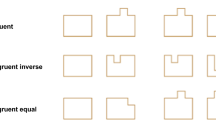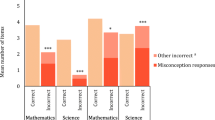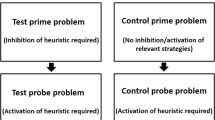Abstract
Students’ difficulties in mathematics and science may stem from interference of the task’s salient irrelevant variables. Here, we focus on a comparison of perimeters task, in which the area is the irrelevant salient variable. In congruent trials (no interference), accuracy is higher and reaction time is shorter than in incongruent trials (area variable interference). A brain-imaging study related to this task indicated that correctly answering the incongruent condition is associated with activation in prefrontal brain regions known for their executive inhibitory control. These findings suggested that intervention aimed at activating inhibitory control mechanisms could improve students’ success. In this paper, we explore the effect of an intervention that explicitly warns about the possible interference of the variable area. Eighty-four sixth graders performed the same comparison of perimeters reaction time test, with warning intervention (warning group) or without it (control group). Accuracy in the warning group was significantly higher in incongruent conditions and reaction time was significantly longer in all conditions than in the control group. The results suggest that the explicit warning activates inhibitory control mechanisms and thus helps students overcome the interference. The findings point to the possibility of improving students’ problem-solving abilities through simple and focused interventions that explicitly warn them about the trap in the task. Such research-based simple interventions appear to require only teachers’ knowledge and awareness and could complement the traditional educational technique of supporting relevant content knowledge.




Similar content being viewed by others
References
Alter, A. (2003) Using the intuitive rule: “More A-More B” in judging images presented in optical instruments. Unpublished Master’s thesis, Tel Aviv University, Tel Aviv, Israel (In Hebrew).
Aron, A. R., Robbins, T. W., & Poldrack, R. A. (2004). Inhibition and the right inferior frontal cortex. Trends in Cognitive Sciences, 8, 170–177.
Babai, R., Levyadun, T., Stavy, R., & Tirosh, D. (2006). Intuitive rules in science and mathematics: a reaction time study. International Journal of Mathematical Education in Science and Technology, 37, 913–924.
Babai, R., Zilber, H., Stavy, R., & Tirosh, D. (2010). The effect of intervention on accuracy of students’ responses and reaction times to geometry problems. International Journal of Science and Mathematics Education, 8, 185–201.
Badair, N. (2002). The use of intuitive rules in solving chemical equilibrium problems. Unpublished Master’s thesis, Tel Aviv University, Tel Aviv, Israel (In Hebrew).
Bar, D. (2001). The influence of the “Equal A equal B” intuitive rule on students’ answers in the field of ionic and molecular solubility. Unpublished Master’s thesis, Tel Aviv University, Tel Aviv, Israel (In Hebrew).
Brebner, J. T., & Welford, A. T. (1980). Introduction: an historical background sketch. In A. T. Welford (Ed.), Reaction times (pp. 1–23). New York: Academic Press.
Carey, S. (1985). Conceptual change in childhood. Cambridge: MIT Press.
Champagne, A. B., Klopfer, L. E., & Anderson, J. H. (1979). Factors influencing the learning of classical mechanics. Pittsburgh: University of Pittsburgh, Learning Research and Development Center.
Cohen, R. (1998). Processes of repeated division of biological and mathematical objects. Unpublished Master’s thesis, Tel Aviv University, Tel Aviv, Israel (In Hebrew).
Confrey, J. (1990). A review of the research on student conceptions in mathematics, science, and programming. Review of Research in Education, 16, 3–56. doi:10.3102/0091732X016001003.
de Fockert, J. W., Rees, G., Frith, C. D., & Lavie, N. (2001). The role of working memory in visual selective attention. Science, 291, 1803–1906.
Dehaene, S., Kerszberg, M., & Changeux, J. P. (1998). A neuronal model of a global workspace in effortful cognitive tasks. Proceedings of the National Academy of Sciences, 95, 14529–14534.
Dempster, F. N., & Corkill, A. J. (1999). Interference and inhibition in cognition and behavior: unifying themes for educational psychology. Educational Psychology Review, 11, 1–88.
Denes, G., & Pizzamiglio, L. (1999). Handbook of clinical and experimental neuropsychology (pp. 28–30). Hove: Psychology Press.
Dewolf, T., Van Dooren, W., Ev Cimen, E., & Verschaffel, L. (2014). The impact of illustrations and warnings on solving mathematical word problems realistically. The Journal of Experimental Education, 82, 103–120.
Dotan, L. (1997). The effects of studying basic probability concepts on the handling of solutions to genetics problems. Unpublished Master’s thesis, Tel Aviv University, Tel Aviv, Israel (In Hebrew).
Driver, R. (1994). Making sense of secondary science. London: Routledge.
Evans, J. B. T., & Over, D. E. (1996). Rationality and reasoning. Hove: Psychology Press.
Faw, B. (2003). Pre-frontal executive committee for perception, working memory, attention, long-term memory, motion control, and thinking: a tutorial review. Consciousness and Cognition, 12, 83–139.
Fias, W., Lammertyn, J., Reynvoet, B., Dupont, P., & Orban, G. A. (2003). Parietal representation of symbolic and nonsymbolic magnitude. Journal of Cognitive Neuroscience, 15, 47–56.
Fischbein, E. (1987). Intuition in science and mathematics. Dordrecht: Reidel.
Flavell, J. H. (1963). The developmental psychology of Jean Piaget. New York: Van Nostrand.
Gazit-Grinboum, R. (2000). Using the intuitive rule “More of A, more of B” among ninth grade students in biology: Genetics and the cell. Unpublished Master’s thesis, Tel Aviv University, Tel Aviv, Israel (In Hebrew).
Gillard, E., Van Dooren, W., Schaeken, W., & Verschaffel, L. (2009). Dual-processes in the psychology of mathematics education and cognitive psychology. Human Development, 52, 95–108.
Goel, V., & Dolan, R. (2003). Explaining modulation of reasoning by belief. Cognition, 87, B11–B22.
Goel, V., Makale, M., & Grafman, J. (2004). The hippocampal system mediates logical reasoning about familiar spatial environments. Journal of Cognitive Neuroscience, 16, 654–664.
Grabner, R. H., & Ansari, D. (2010). Promises and potential pitfalls of a ‘cognitive neuroscience of mathematics learning’. ZDM—The International Journal on Mathematics Education, 42, 655–660.
Green, D. R. (1983). A survey of probabilistic concepts in 3000 students aged 11–16 years. In D. R. Grey, P. Holmes, V. Barnett, & G. M. Constable (Eds.), Proceedings of the First International Conference on Teaching Statistics (pp. 766–783). Sheffield: Teaching Statistics Trust.
Hakham-Aharon, A. (1997). The influence of the intuitive rule “More of A, more of B” on children’s concept of time. Unpublished Master’s thesis, Tel Aviv University, Tel Aviv, Israel (In Hebrew).
Houdé, O., & Guichart, E. (2001). Negative priming effect after inhibition of number/length interference in a Piaget-like task. Developmental Science, 4, 119–123.
Houdé, O., Zago, L., Mellet, E., Moutier, S., Pineau, A., Mazoyer, B., & Tzourio-Mazoyer, N. (2000). Shifting from the perceptual brain to the logical brain: the neural impact of cognitive inhibition training. Journal of Cognitive Neuroscience, 12, 721–728.
Konishi, S., Nakajima, K., Uchida, I., Kikyo, H., Kameyama, M., & Miyashita, Y. (1999). Common inhibitory mechanism in human inferior prefrontal cortex revealed by event-related functional MRI. Brain, 122, 981–991.
Lamy, D., Leber, A., & Egeth, H. E. (2004). Effects of task relevance and stimulus-driven salience in feature-search mode. Journal of Experimental Psychology: Human Perception and Performance, 30, 1019–1031.
Lavie, N. (2005). Distracted and confused? Selective attention under load. Trends in Cognitive Sciences, 9, 75–82.
Lavie, N., Hirst, A., de Fockert, J. W., & Viding, E. (2004). Load theory of selective attention and cognitive control. Journal of Experimental Psychology: General, 133, 339–354.
Lawson, A. E. (1995). Science teaching and the development of thinking. Belmont: Wadsworth.
Levy, S. (1998). The use of intuitive rules in solving problems dealing with simple electronic circuits. Unpublished Master’s thesis, Tel Aviv University, Tel Aviv, Israel (In Hebrew).
Livne, T. (1996). Examination of high school students’ difficulties in understanding the change in surface area, volume and surface area/volume ratio with the change in size and/or shape of a body. Unpublished Master’s thesis, Tel Aviv University, Tel Aviv, Israel (In Hebrew).
Lleras, A., & Von Mühlenen, A. (2004). Spatial context and top-down strategies in visual search. Spatial Vision, 17, 465–482.
Martin, M. O., Mullis, I. V., Foy, P., & Stanco, G. M. (2012). TIMSS 2011 international results in Science. Amsterdam: International Association for the Evaluation of Educational Achievement.
Masson, S., Potvin, P., Riopel, M., & Foisy, L. M. B. (2014). Differences in brain activation between novices and experts in science during a task involving a common misconception in electricity. Mind, Brain, and Education, 8, 44–55.
Mendel, N. (1998). The intuitive rule “Same of A, same of B”: The case of comparison of rectangles. Unpublished Master’s thesis, Tel Aviv University, Tel Aviv, Israel (In Hebrew).
Morabia, D. (1990). Difficulties in applying the principle of the “independence of motions” among high school students. Unpublished Master’s thesis, Tel Aviv University, Tel Aviv, Israel (In Hebrew).
Moutier, S., Angeard, N., & Houdé, O. (2002). Deductive reasoning and matching-bias inhibition training: evidence from a debiasing paradigm. Thinking & Reasoning, 8, 205–224.
Moutier, S., & Houdé, O. (2003). Judgement under uncertainty and conjunction fallacy inhibition training. Thinking & Reasoning, 9, 185–201.
Mudrik, E. (2003). The perception of Physics pupils at high school on the relation between two variables as direct proportional relationship or inverse proportional relationship. Unpublished Master’s thesis, Tel Aviv University, Tel Aviv, Israel (In Hebrew).
Mullis, I. V., Martin, M. O., Foy, P., & Arora, A. (2012). TIMSS 2011 international results in Mathematics. Amsterdam: International Association for the Evaluation of Educational Achievement.
Myers, S. (1998). Effects of conceptual conflicts on using the intuitive rule “More of A, more of B” in 8th grade students. Unpublished Master’s thesis, Tel Aviv University, Tel Aviv, Israel (In Hebrew).
Norenzayan, A., Smith, E. E., Kim, B., & Nisbett, R. E. (2002). Cultural preferences for formal versus intuitive reasoning. Cognitive Science, 26, 653–684.
Novak, J. D., & Gowin, D. B. (1984). Learning how to learn. Cambridge: Cambridge University Press.
OECD (2014). PISA 2012 Results: What students know and can do: Student performance in Mathematics, Reading and Science (Volume I, Revised Edition, February 2014). OECD Publishing. doi:10.1787/9789264208780-en.
Osborne, R., & Freyberg, P. (1985). Learning in science. Auckland: Heinemann.
Osman, M., & Stavy, R. (2006). Development of intuitive rules: evaluating the application of the dual-system framework to understanding children’s intuitive reasoning. Psychonomic Bulletin & Review, 13, 935–953.
Piaget, J., & Inhelder, B. (1974). The child’s construction of quantities: Conservation and atomism. London: Routledge & Kegan Paul.
Pinel, P., Piazza, M., Le Bihan, D., & Dehaene, S. (2004). Distributed and overlapping cerebral representations of number, size, and luminance during comparative judgments. Neuron, 41, 983–993.
Rapaport, A. (1998). Use of the intuitive rule “More of A, more of B” in comparing algebraic expressions. Unpublished Master’s thesis, Tel Aviv University, Tel Aviv, Israel (In Hebrew).
Ravia, N. (1992). Inconsistencies in the perception of the concepts heat and temperature (9th grade). Unpublished Master’s thesis, Tel Aviv University, Tel Aviv, Israel (In Hebrew).
Rogers, R. D., Owen, A. M., Middleton, H. C., Williams, E. J., Pickard, J. D., Sahakian, B. J., & Robbins, T. W. (1999). Choosing between small, likely rewards and large, unlikely rewards activates inferior and orbital prefrontal cortex. The Journal of Neuroscience, 19, 9029–9038.
Rojhany, L. (1997). The use of the intuitive rule “More of A, more of B”: The case of comparison of angles. Unpublished Master’s thesis, Tel Aviv University, Tel Aviv, Israel (In Hebrew).
Shayer, M., & Adey, P. (1981). Towards a science of science teaching: Cognitive development and curriculum demand. Oxford: Heinemann Educational.
Sigman, M., Pena, M., Goldin, A. P., & Ribeiro, S. (2014). Neuroscience and education: prime time to build the bridge. Nature Neuroscience, 17, 497–502.
Sloman, S. (1996). The empirical case for two systems of reasoning. Psychological Bulletin, 119, 30–32.
Sobel, K. V., & Cave, K. R. (2002). Roles of salience and strategy in conjunction search. Journal of Experimental Psychology: Human Perception and Performance, 28, 1055–1070.
Stavy, R., & Babai, R. (2008). Complexity of shapes and quantitative reasoning in geometry. Mind, Brain, and Education, 2, 170–176.
Stavy, R., & Babai, R. (2010). Overcoming intuitive interference in mathematics: insights from behavioral, brain imaging and intervention studies. ZDM—The International Journal on Mathematics Education, 42, 621–633.
Stavy, R., Babai, R., Tsamir, P., Tirosh, D., Lin, F. L., & McRobbie, C. (2006a). Are intuitive rules universal? International Journal of Science and Mathematics Education, 4, 417–436.
Stavy, R., Goel, V., Critchley, H., & Dolan, R. (2006b). Intuitive interference in quantitative reasoning. Brain Research, 1073–1074, 383–388.
Stavy, R., & Tirosh, D. (2000). How students (mis-)understand science and mathematics. New York: Teachers College Press.
Tall, D., & Vinner, S. (1981). Concept image and concept definition in mathematics with particular reference to limits and continuity. Educational Studies in Mathematics, 12, 151–169.
Tang, J., Critchley, H. D., Glaser, D. E., Dolan, R. J., & Butterworth, B. (2006). Imaging informational conflict: a functional magnetic resonance imaging study of numerical Stroop. Journal of Cognitive Neuroscience, 18, 2049–2062.
Tversky, A., & Kahneman, D. (1983). Extensional versus intuitive reasoning: the conjunction fallacy in probability judgment. Psychological Review, 90, 293–315.
Vosniadou, S., & Ioannides, C. (1998). From conceptual development to science education: a psychological point of view. International Journal of Science Education, 20, 1213–1230.
Welford, A. T. (1980). Reaction times. New York: Academic Press.
Yoshida, H., Verschaffel, L., & De Corte, E. (1997). Realistic considerations in solving problematic word problems: do Japanese and Belgian children have the same difficulties? Learning and Instruction, 7, 329–338.
Zink, C. F., Pagnoni, G., Martin-Skurski, M. E., Chappelow, J. C., & Berns, G. S. (2004). Human striatal responses to monetary reward depend on saliency. Neuron, 42, 509–517.
Author information
Authors and Affiliations
Corresponding author
Rights and permissions
About this article
Cite this article
Babai, R., Shalev, E. & Stavy, R. A warning intervention improves students’ ability to overcome intuitive interference. ZDM Mathematics Education 47, 735–745 (2015). https://doi.org/10.1007/s11858-015-0670-y
Accepted:
Published:
Issue Date:
DOI: https://doi.org/10.1007/s11858-015-0670-y




